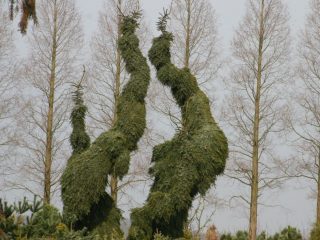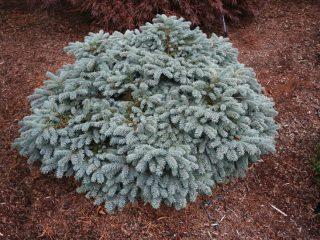Content
- 1 History of origin
- 2 Description of Norway spruce Nidiformis
- 3 Advantages and disadvantages
- 4 Planting spruce Nidiformis
- 5 Caring for Nidiformis spruce
- 6 Reproduction of spruce Nidiformis
- 7 Diseases and pests
- 8 Photo of Nidiformis spruce in the landscape
- 9 Conclusion
- 10 Reviews of the common spruce Nidiformis
Decorating the garden with coniferous trees has become commonplace. When choosing a plant, many people pay attention to Nidiformis spruce. The following qualities make the culture popular: unpretentiousness, heavy cones, tasty nuts, decorative appearance.
History of origin
The plant was bred at the beginning of the last century. The originator was the German botanist Rulman Grisson. Spruce Nidiformis has received several awards. It entered the official register in 1904.
Description of Norway spruce Nidiformis
Nidiformis is an evergreen spruce with a unique crown that resembles a soft pillow. The branches tend to grow laterally, so the plant constantly increases in volume. Horizontal growth is noticeable even in young plantings.

Adult specimens have a lush but neat shape
Spruce Nidiformis does not suffer from sagging branches. It has dense foliage reaching 11 mm in length. It is pleasant to the touch and does not prick. Depending on growing conditions, it may have a dark green or light green color.Unlike other Germanic spruces, Nidiformis has no blue spots.
At the beginning of growth, the cones are bright green. After a few months they become brown and gain mass. The shape of the fruit is cylindrical. Cones form in early autumn. The roots of the Nidiformis spruce can be called developed. They have a flat but branched structure. This allows the seedling to receive all the necessary elements.
The cushion spruce Nidiformis is recommended for planting in central Russia. It has significant winter hardiness, although it can grow in the south. The lifespan of a tree is about 200-300 years. It has a strong immune system, so it will not be difficult for the owner to take care of the plant.
Height of spruce Nidiformis
The culture is a dwarf variety. The average height is limited to 1 m, width - 3 m. In their native country, the Nidiformis spruce variety is more than 200 cm high. This is due to the age of planting. They have a neat crown because the branches are layered on top of each other.
Growth rate
Spruce Nidiformis is classified as a long-growing variety. The annual growth is from 3 to 5 cm. That is, in 10 years the crop will reach approximately 45 cm.
Advantages and disadvantages
European spruce Nidiformis is suitable for growing in different regions of Russia. It has bright foliage that can brighten up an otherwise unremarkable garden.

In autumn, Nidiformis produces cones that contain edible nuts.
Pros:
- good branching;
- winter hardiness;
- neat pillow-shaped crown;
- optional pruning;
- resistance to weather conditions;
- survival in any soil;
- low lighting requirements;
- soft needles.
Minuses:
- slow growth;
- low resistance to heat.
Planting spruce Nidiformis
There are no specific planting dates. The purchased seedling can be planted in the ground in spring, summer or autumn. Favorable conditions will be warm weather (no more than +28 degrees), no night frosts. Gardeners note that the plant becomes active in late spring and early August. You can use this time for work.
Dig a hole at a distance equal to the diameter of the roots. The average hole is 40x40 cm. Nidiformis spruce requires drainage from crushed stone and sand. Pour a layer of 15-20 cm. The soil is mixed with complex fertilizer, and a seedling is placed. Finally, water and place sawdust near the roots.
Caring for Nidiformis spruce
This is one of the most unpretentious varieties of German spruce. The culture grows well at the edge of the forest, but is not afraid of the shade. Planting on the east side should be avoided.

Due to high temperatures, soft foliage fades and loses color.
Nidiformis spruce is also undemanding regarding the nature of the soil. Botanists advise using a loose substrate filled with nutrients. Acidity is preferably neutral. The plant takes root in loamy, saline, acidic, alkaline, nitrogen soils.
After landing, daily inspection is carried out. Spruce Nidiformis should not dry out in the sun. If time permits, the tree is covered in summer. In hot weather, water once every seven days. One bucket per young seedling is enough. In other seasons, the plant produces water on its own; during periods of drought, it is recommended to irrigate it.
Spruce Nidiformis prefers cool weather. It survives the Russian winter without problems, requiring shelter only in the regions of the far north. If the thermometer shows below 40 degrees, build a shelter. In other cases this is not done.
Temperatures within -15 degrees are optimal for life. By winter, the crop is sprayed with Purshat-K, if necessary. In Siberia, the plant is covered with non-woven material to prevent burns. If other conifers have demonstrated the likelihood of a threat, you can cover them with a hut or net.
The miniature size of Nidiformis spruce allows it to be grown at home. The pot must be rotated so that the needles are illuminated from each side. The crop is watered and irrigated.
Reproduction of spruce Nidiformis
Daughter plants are obtained from cuttings. The tree must be 5 years old or more. Use central shoots located deep in the crown. They are cut into 10 cm pieces. Excess foliage and irregularities are removed. The raw materials are placed in a rooting solution, for example, in “Kornevin”.
The next day, dig a small hole (up to 7 cm). Stick the cutting at an acute angle, like garden roses.

After 60-100 days the first roots will appear
Diseases and pests
Norway spruce (picea abies nidiformis) is not afraid of most pests and diseases. The only weakness is rotting due to stagnation of moisture. In this case, the fungus colonizes. To protect the tree, it is treated with fungicides or Bordeaux mixture.
Major pests include hermes, spider mites and sawflies.If the Nidiformis spruce is young, when spraying it is better to limit yourself to folk remedies. The needles and branches are treated with a soap solution. In case of serious damage, they switch to chemical insecticides.
Photo of Nidiformis spruce in the landscape

Nidiformis is usually combined in a flowerbed with other conifers

Stone paths are decorated with wood, forming a hedge

Coniferous plant looks great in combination with natural stone and pebbles

The variety is sometimes used to create contrast with other plantings
Conclusion
Spruce Nidiformis is recommended by both European and Russian summer residents. The culture requires minimal care. The disadvantage is drought tolerance and slow growth. The tree has strong immunity, which is disrupted by frequent watering. Therefore, irrigation should be carried out only after the soil has dried.
Reviews of the common spruce Nidiformis








